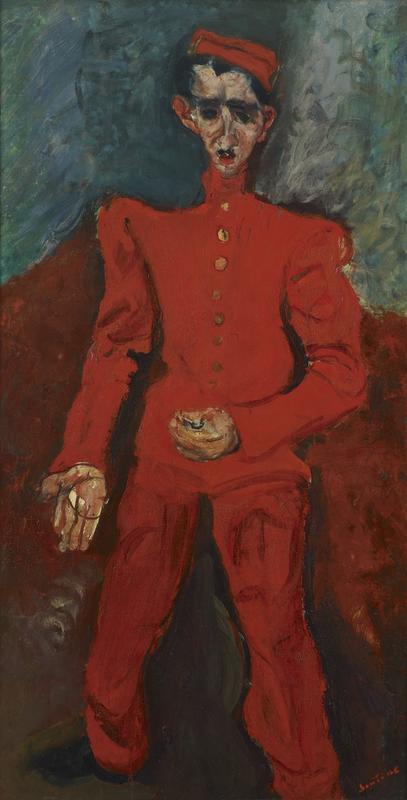More about Page Boy at Maxim's

Contributor
Chaim Soutine's Page-Boy at Maxim's, portraying a worker at one of the top Parisian restaurants, has transfixed generations as an installment in his career-long series of works which emphasize the color red.
One magazine article, from fourteen years after the opening of Maxim's, gushes, "There is magic in the name of Maxim's. Not to know Maxim's is not to know Paris." The late, great painter Marevna Vorobieff compares the lines of this painting to those of El Greco. As with many aspects of the life of Soutine, there are question marks around this work: the owner, for example, gives the date as 1927, but Soutine's primary biographer gives 1925.
Willem de Kooning once said of Soutine's work, "I remember when I first saw the Soutines in the Barnes Collection...the Matisses had a light of their own, but the Soutines had a glow that came from within the paintings—it was another kind of light." Ray Elliott uses the painter and critic Andrew Forge's de Kooning-like account of viewing Page-Boy at Maxim's to ask: when an artwork makes a critic, especially a big-cheese, well-published, well-connected critic, have a "flight of fancy," an intense, magical, imaginative experience, does the critic's writing about this experience count as "real" and legitimate art criticism? When critics shed their robes of impartial objectivity, like the food critic at the end of the animated movie Ratatouille, have they failed to deliver? Elliott says no, on the contrary: the fact that Forge had such a profound emotional response to Page-Boy at Maxim's allows for his audience to have one as well.
How does Soutine make magic with Page-Boy at Maxim's? The color, for one. Red is a marker of protection—Gina Wilde writes that Bedouin women in the Niger desert paint young lambs red in order to keep them from predation. The reddest lipstick is the most arresting, the red light makes you press the brake, the practice of feng shui recommends painting the front door red for prosperity. The excellent Soutine biographer Klaus H. Carl, analyzing Page-Boy at Maxim's, makes a subjective list of other Soutine paintings which share the combination of red and green, although none of them feature elves or reindeer: the Old Woman (c. 1923-24, Cleveland Museum of Art), the Old Seated Lady (c. 1923-24) which pulled in about $3.86 million in 2013, the Depravation, and Young Girl in Pink (1924).
If the owner of the painting is correct about the date, Page-Boy at Maxim's is from a two-year period during which Soutine produced around thirty portraits. One of these, Le petit patissier (The Little Baker) sold for $18,043,750, including commission, breaking Soutine's auction record. Many of his 1920's portraits show everyday people he saw in France, including The Cook of Cagnes, Le Garçon de'étage (The Room-Service Waiter, Musée de l'Orangerie), The Valet, and Female Nude (Eve), the last of which sold for $1.5 million.
Sources
- Carl, Klaus H. Soutine. New York: Parkstone, 2015.
- Elliott, Ray K. "Imagination in the Experience of Art." Royal Institute of Philosophy Supplements 6 (1972): 88-105.
- Jarman, Derek. Chroma: A Book of Colour—June '93. New York: Random House, 2017.
- Michaud, Chris. "New Soutine record set as Christie's meets Impressionist goal." Reuters, May 3, 2013, https://www.reuters.com/article/us-art-auction-soutine-idUSBRE94803I201….
- Posèq, Avigdor W. G. Soutine: His Jewish Modality. Leicester, UK: Book Guild, 2001.
- Sylvester, David. About Modern Art. New Haven: Yale University Press, 2001.
- The Bystander: An Illustrated Weekly, Devoted to Travel, Literature, Art, the Drama, Progress, Locomotion, Volume 16. London: 1907.
- Vorobëv, Marevna. Life with the Painters of La Ruche. New York: Macmillan, 1974.
- Weintroub, Benjamin. The Chicago Jewish Forum, Volume 10. Chicago: The Chicago Jewish Forum, 1951.
- Wilde, Gina. The Alchemy of Color Knitting: The Art and Technique of Mastering Exquisite Palettes. New York: 2009, Random House.











